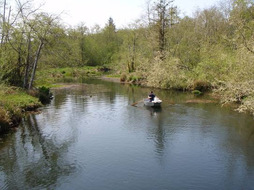Tribes




Salmon are a fundamental part of tribal identity for the Yurok, Karuk and Hoopa Valley people. Salmon affects people’s economy, community, and culture. This year, 2017, marks the second year in a row that there was not enough fish for subsistence, ceremonial, or commercial purposes.
The tribes are helping to increase the populations of salmon in the rivers that support their livelihood and culture. The tribes have been instrumental in doing restoration projects as well as advocating environmental issues along their rivers.
Yurok Tribe
The Yurok Tribal Fisheries Program is dedicated to understanding, managing, conserving, and restoring fish populations of the Klamath Basin for the benefit of present and future generations of Yurok People. The Yurok Tribal Fisheries Program includes: Harvest Management Division (engages in all aspects of fishery harvest management and monitors the Yurok fishery); Lower Klamath Division (conducts research, monitoring, and restoration of fisheries resources in the Lower Klamath River Sub-basin); Trinity River Division (research, monitoring, and restoration of Trinity River fishery resources); and Klamath River Division (conducts research and monitoring throughout the watershed with a focus on informing water management policy).
The Yurok Tribe assess and implement slope stabilization projects within the Lower Klamath River Basin. It is their goal to restore the fisheries population of the basin by reducing sediment from the streams that flow into the river. The Yurok Tribe has conducted direct snorkel observation of thermal refugia sites for fifteen years, and has an extensive data set on the location and usage of these areas. The Yurok Tribe used hand construction methods to improve fish passage and to install simple cover elements to thermal refugial areas. Tribal Fisheries personnel consolidated braided flow channels into a single coherent stream channel at Pecwan, Tully, Ke’pel, Pine, Roach and Bluff Creeks, and introduced simple cover elements at several of these sites as appropriate. In February 2017, the Yurok Tribe, with other tribes and conservation groups, won two lawsuits that produced new protections for Klamath salmon requiring increased water flows to mitigate fish disease outbreaks. The Yurok tribe continues to advocate for removal of the lower four Klamath dams, which are a primary driver of the juvenile disease problem and water quality issues. Learn more
Karuk Tribe
The Karuk Tribe’s goal is to protect watersheds that serve as habitat for Tribal trust species while maximizing the Tribe’s and local communities long-term economic and cultural benefits. An objective of the Watershed Restoration Division is to protect the habitat of anadromous fish by decreasing the sedimentation caused by the road networks within watersheds of critical concern. The Tribe accomplishes this by conducting site-specific geomorphic mapping, surveying, prescription design and preparation of work order specifications for implementation of identified project areas. Implementation includes proven road decommissioning methods to remove and/or stabilize unstable logging haul road-stream crossings and to reestablish the natural hillslope drainage pattern along the road. The objective of a decommissioning project is to decrease the sedimentation caused by a road by removing the potential sediment. Decommissioning of roads begin with roads that have the highest density of high hazard sites and that pose the greatest hazard to watershed processes, water quality, and aquatic habitats. The Karuk Tribe partnered with the local non-profit, Middle Klamath Water Council (MKWC) to plan, design and construct off channel habitats. On Seiad Creek, construction of a large off-channel habitat unit including three off channel ponds within the project reach. The Karuk Tribe also works on assessing the effects of Dwinnell Dam on the Shasta River and possible recovery actions including dam removal and fish bypass. Learn more
Hoopa Valley Tribe
Hoopa Valley Tribal Fisheries Department is implementing tributary enhancement projects like removing channelization and levees, plus lowering of streamside surfaces to elevations ensuring regular, annual flow of floodwaters into expansive streamside edges to improve fish and identified priority riparian habitat along Mill and Supply Creeks located within the Hoopa Valley Indian Reservation. Large wood elements were placed throughout floodplain areas, in locations where additional wood will likely be captured when transported into the reach from above. Through these recovery actions, the quality and quantity of salmonid habitat in Supply Creek was increased, helping to restore coho salmon and other salmonids in the Trinity Basin. From a watershed-wide perspective, restoration of the valley floor reach of Supply Creek provides substantial low-gradient winter rearing habitat for both natal and non-natal salmonids in the Trinity Basin.